Abstract
Paternal isodisomy for chromosome 5 was detected in a 2-year-old boy with type III spinal muscular atrophy (SMA), an autosomal recessive degenerative disorder of alpha motor neurons, known to map to 5q11.2-13.3. Examination of 17 short-sequence repeat polymorphisms spanning 5p15.1-15.3 to 5q33.3-qter produced no evidence of maternally inherited alleles. Cytogenetic analysis revealed a normal male karyotype, and FISH with probes closely flanking the SMA locus confirmed the presence of two copies of chromosome 5. No developmental abnormalities, other than those attributable to classical childhood-onset SMA, were present. While the absence of a maternally derived chromosome 5 could have produced the symptoms of SMA through the mechanism of genomic imprinting, the lack of more global developmental abnormalities would be unusual. Paternal transmission of two copies of a defective gene at the SMA locus seems to be the most likely cause of disease, but proof of this will have to await the identification of the SMA gene. While uniparental isodisomy is a rare event, it must be considered as a possible mechanism involved in SMA when conducting prenatal testing and counseling for this disorder.
Full text
PDF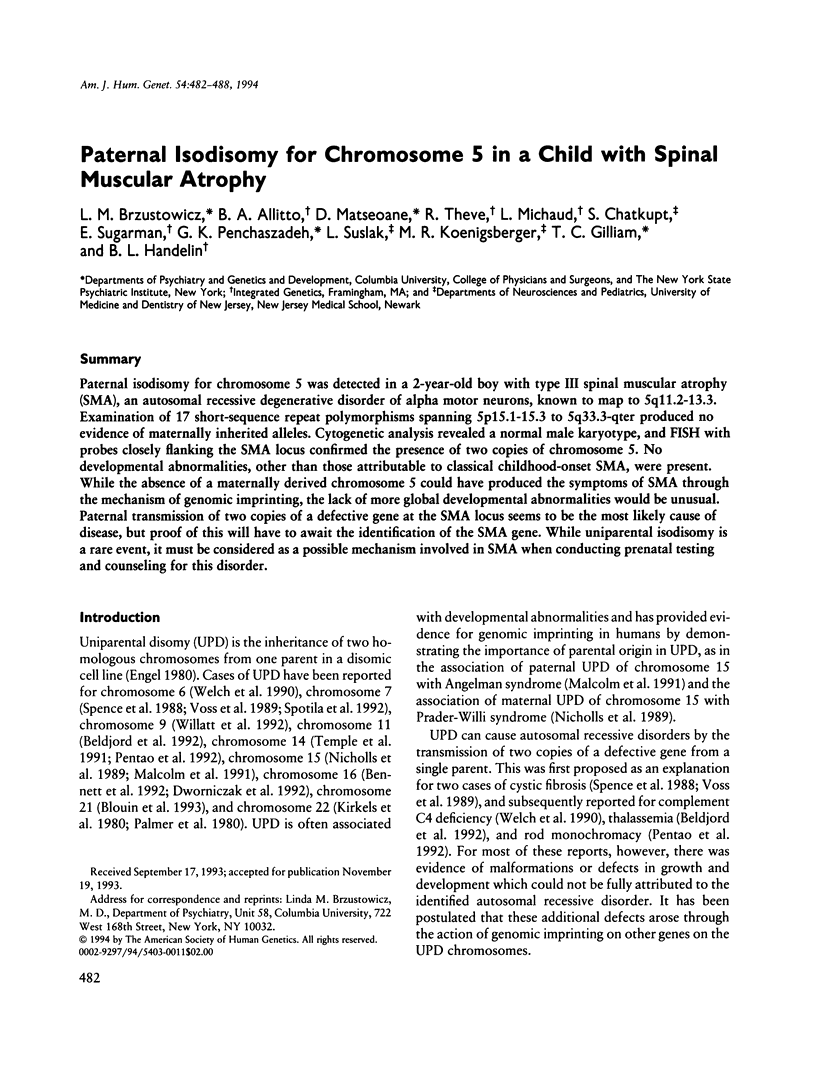

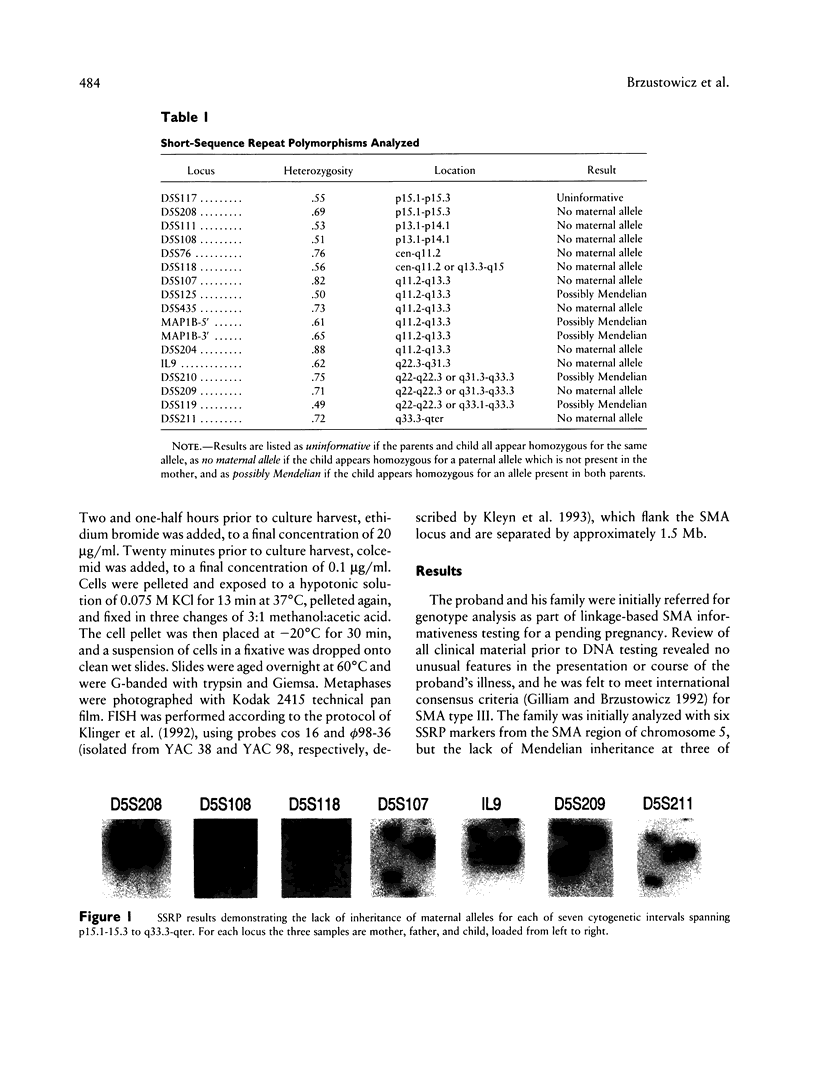
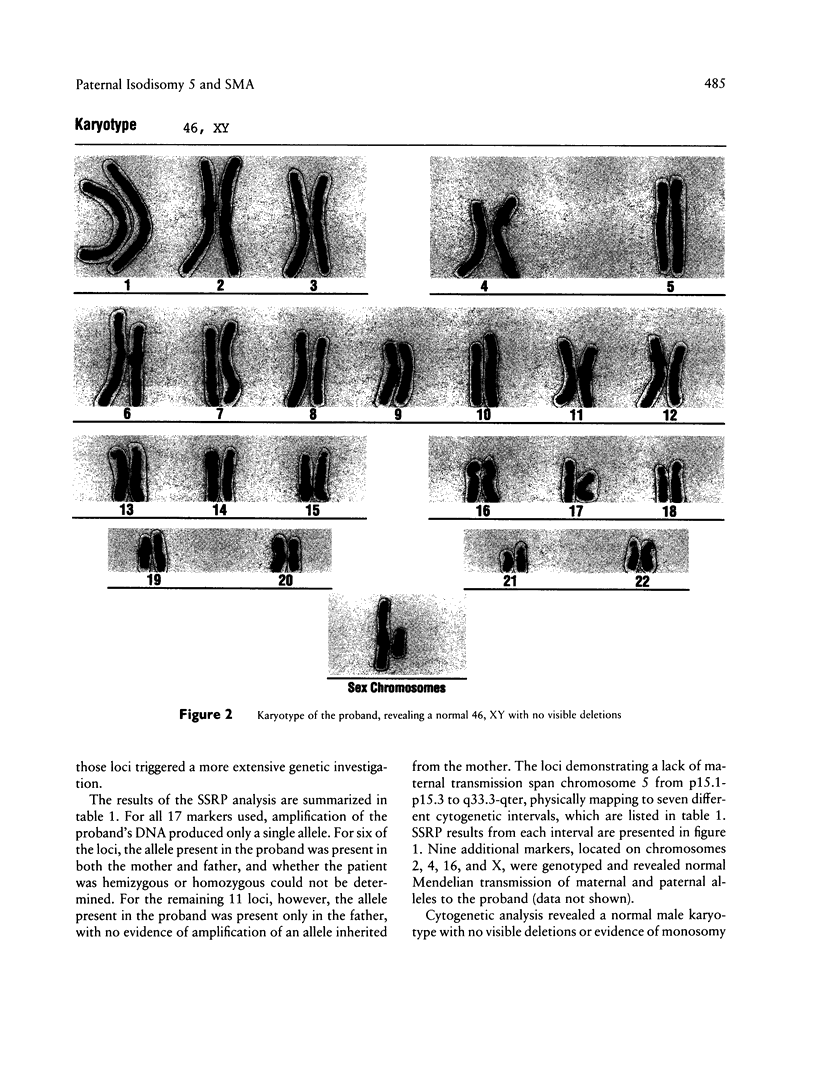
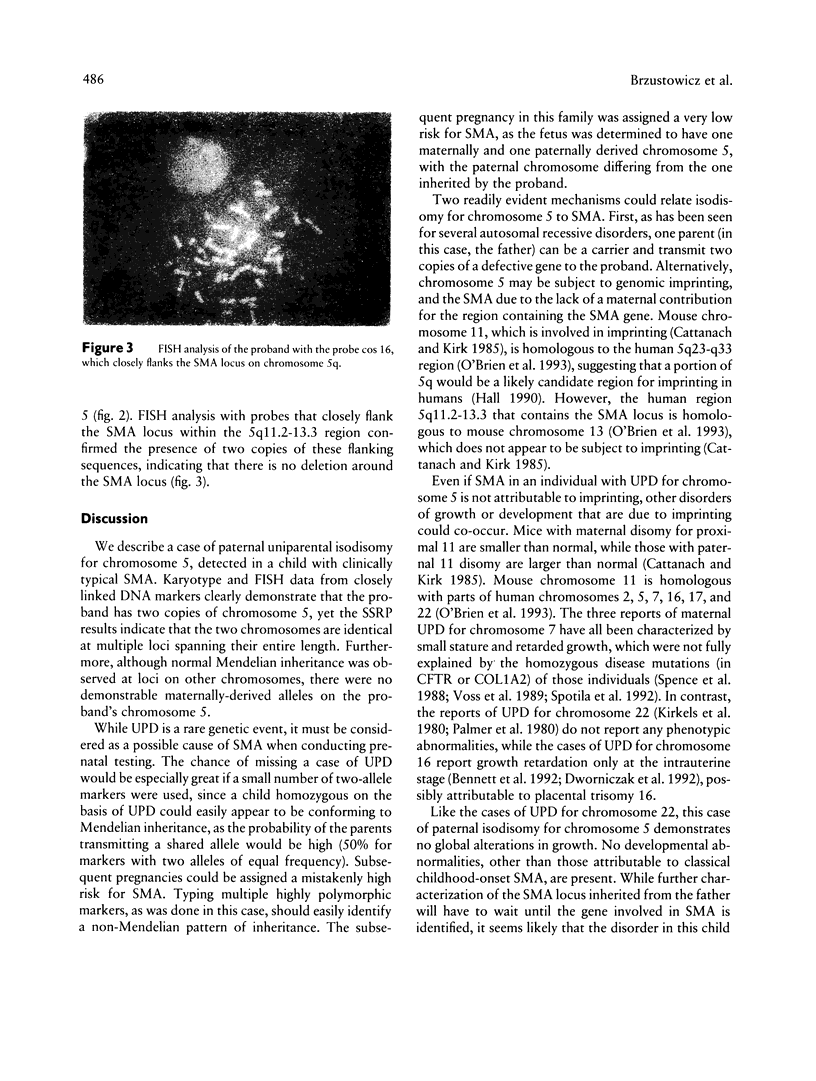
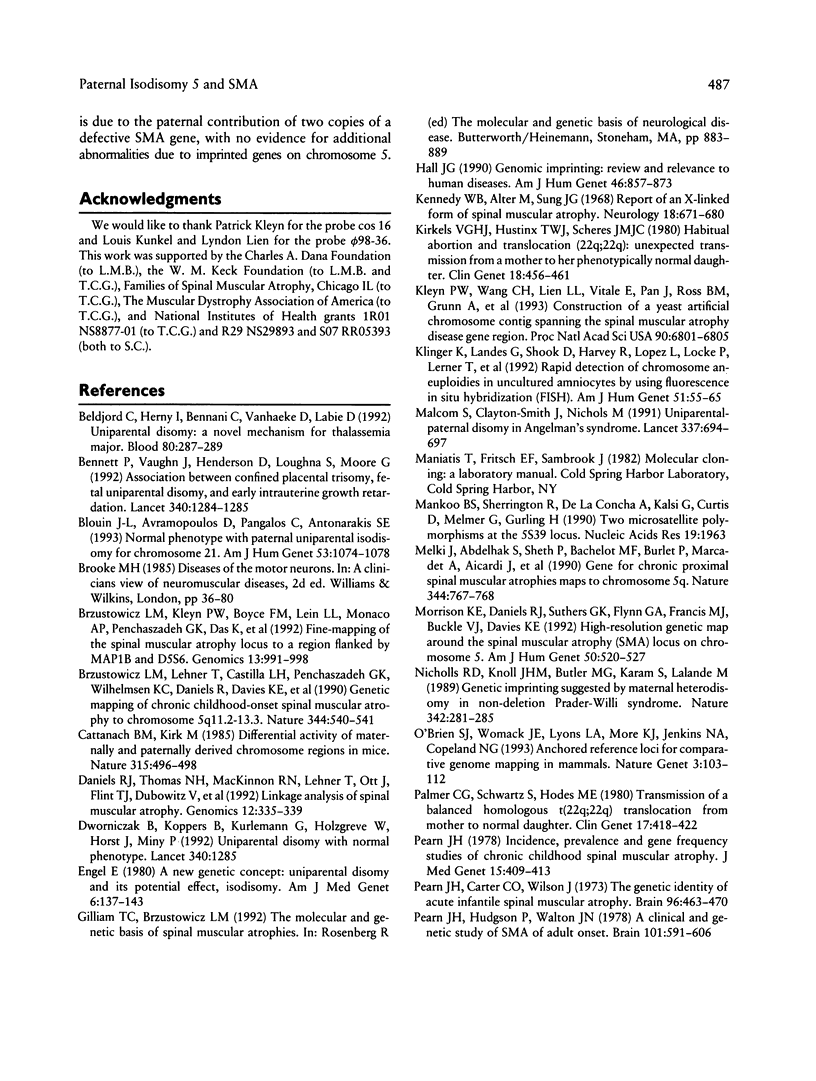
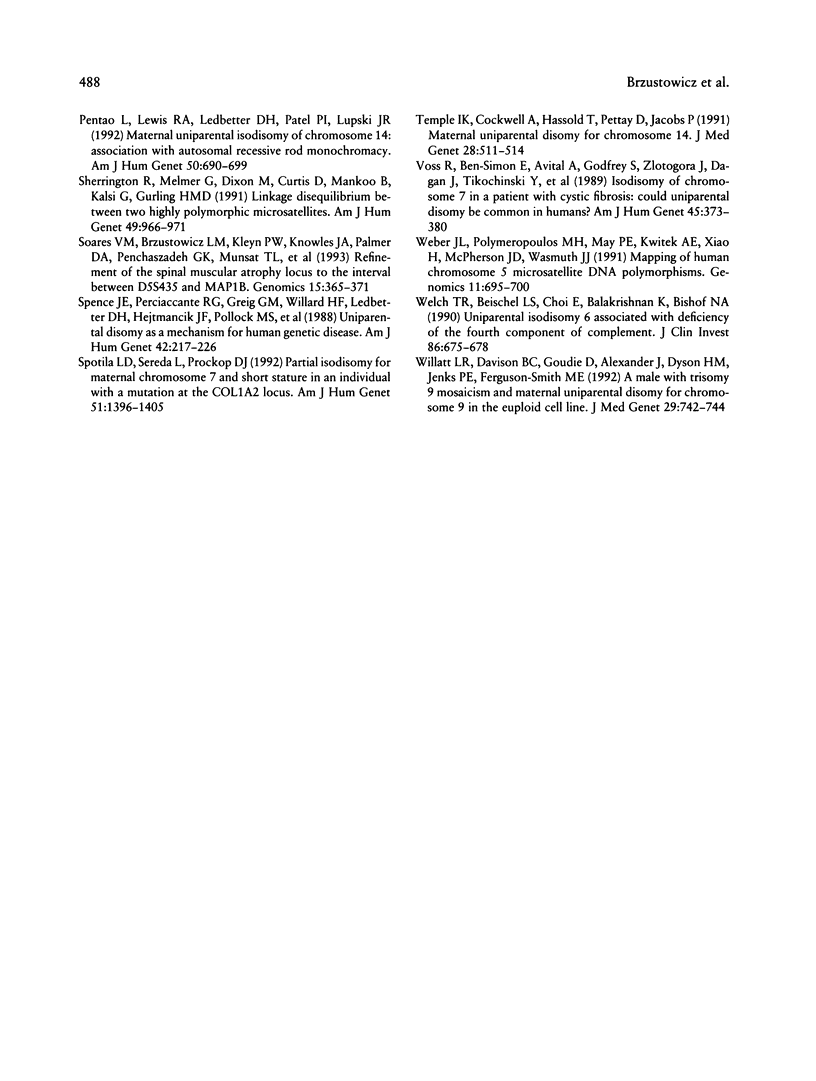
Images in this article
Selected References
These references are in PubMed. This may not be the complete list of references from this article.
- Beldjord C., Henry I., Bennani C., Vanhaeke D., Labie D. Uniparental disomy: a novel mechanism for thalassemia major. Blood. 1992 Jul 1;80(1):287–289. [PubMed] [Google Scholar]
- Bennett P., Vaughan J., Henderson D., Loughna S., Moore G. Association between confined placental trisomy, fetal uniparental disomy, and early intrauterine growth retardation. Lancet. 1992 Nov 21;340(8830):1284–1285. doi: 10.1016/0140-6736(92)92980-t. [DOI] [PubMed] [Google Scholar]
- Blouin J. L., Avramopoulos D., Pangalos C., Antonarakis S. E. Normal phenotype with paternal uniparental isodisomy for chromosome 21. Am J Hum Genet. 1993 Nov;53(5):1074–1078. [PMC free article] [PubMed] [Google Scholar]
- Brzustowicz L. M., Kleyn P. W., Boyce F. M., Lien L. L., Monaco A. P., Penchaszadeh G. K., Das K., Wang C. H., Munsat T. L., Ott J. Fine-mapping of the spinal muscular atrophy locus to a region flanked by MAP1B and D5S6. Genomics. 1992 Aug;13(4):991–998. doi: 10.1016/0888-7543(92)90012-h. [DOI] [PubMed] [Google Scholar]
- Brzustowicz L. M., Lehner T., Castilla L. H., Penchaszadeh G. K., Wilhelmsen K. C., Daniels R., Davies K. E., Leppert M., Ziter F., Wood D. Genetic mapping of chronic childhood-onset spinal muscular atrophy to chromosome 5q11.2-13.3. Nature. 1990 Apr 5;344(6266):540–541. doi: 10.1038/344540a0. [DOI] [PubMed] [Google Scholar]
- Cattanach B. M., Kirk M. Differential activity of maternally and paternally derived chromosome regions in mice. Nature. 1985 Jun 6;315(6019):496–498. doi: 10.1038/315496a0. [DOI] [PubMed] [Google Scholar]
- Daniels R. J., Thomas N. H., MacKinnon R. N., Lehner T., Ott J., Flint T. J., Dubowitz V., Ignatius J., Donner M., Zerres K. Linkage analysis of spinal muscular atrophy. Genomics. 1992 Feb;12(2):335–339. doi: 10.1016/0888-7543(92)90382-3. [DOI] [PubMed] [Google Scholar]
- Dworniczak B., Koppers B., Kurlemann G., Holzgreve W., Horst J., Miny P. Uniparental disomy with normal phenotype. Lancet. 1992 Nov 21;340(8830):1285–1285. doi: 10.1016/0140-6736(92)92981-k. [DOI] [PubMed] [Google Scholar]
- Engel E. A new genetic concept: uniparental disomy and its potential effect, isodisomy. Am J Med Genet. 1980;6(2):137–143. doi: 10.1002/ajmg.1320060207. [DOI] [PubMed] [Google Scholar]
- Hall J. G. Genomic imprinting: review and relevance to human diseases. Am J Hum Genet. 1990 May;46(5):857–873. [PMC free article] [PubMed] [Google Scholar]
- Kennedy W. R., Alter M., Sung J. H. Progressive proximal spinal and bulbar muscular atrophy of late onset. A sex-linked recessive trait. Neurology. 1968 Jul;18(7):671–680. doi: 10.1212/wnl.18.7.671. [DOI] [PubMed] [Google Scholar]
- Kirkels V. G., Hustinx T. W., Scheres J. M. Habitual abortion and translocation (22q;22q): unexpected transmission from a mother to her phenotypically normal daughter. Clin Genet. 1980 Dec;18(6):456–461. doi: 10.1111/j.1399-0004.1980.tb01794.x. [DOI] [PubMed] [Google Scholar]
- Kleyn P. W., Wang C. H., Lien L. L., Vitale E., Pan J., Ross B. M., Grunn A., Palmer D. A., Warburton D., Brzustowicz L. M. Construction of a yeast artificial chromosome contig spanning the spinal muscular atrophy disease gene region. Proc Natl Acad Sci U S A. 1993 Jul 15;90(14):6801–6805. doi: 10.1073/pnas.90.14.6801. [DOI] [PMC free article] [PubMed] [Google Scholar]
- Klinger K., Landes G., Shook D., Harvey R., Lopez L., Locke P., Lerner T., Osathanondh R., Leverone B., Houseal T. Rapid detection of chromosome aneuploidies in uncultured amniocytes by using fluorescence in situ hybridization (FISH). Am J Hum Genet. 1992 Jul;51(1):55–65. [PMC free article] [PubMed] [Google Scholar]
- Malcolm S., Clayton-Smith J., Nichols M., Robb S., Webb T., Armour J. A., Jeffreys A. J., Pembrey M. E. Uniparental paternal disomy in Angelman's syndrome. Lancet. 1991 Mar 23;337(8743):694–697. doi: 10.1016/0140-6736(91)90278-w. [DOI] [PubMed] [Google Scholar]
- Mankoo B. S., Sherrington R., De La Concha A., Kalsi G., Curtis D., Melmer G., Gurling H. M. Two microsatellite polymorphisms at the D5S39 locus. Nucleic Acids Res. 1991 Apr 25;19(8):1963–1963. doi: 10.1093/nar/19.8.1963-a. [DOI] [PMC free article] [PubMed] [Google Scholar]
- Melki J., Abdelhak S., Sheth P., Bachelot M. F., Burlet P., Marcadet A., Aicardi J., Barois A., Carriere J. P., Fardeau M. Gene for chronic proximal spinal muscular atrophies maps to chromosome 5q. Nature. 1990 Apr 19;344(6268):767–768. doi: 10.1038/344767a0. [DOI] [PubMed] [Google Scholar]
- Morrison K. E., Daniels R. J., Suthers G. K., Flynn G. A., Francis M. J., Buckle V. J., Davies K. E. High-resolution genetic map around the spinal muscular atrophy (SMA) locus on chromosome 5. Am J Hum Genet. 1992 Mar;50(3):520–527. [PMC free article] [PubMed] [Google Scholar]
- Nicholls R. D., Knoll J. H., Butler M. G., Karam S., Lalande M. Genetic imprinting suggested by maternal heterodisomy in nondeletion Prader-Willi syndrome. Nature. 1989 Nov 16;342(6247):281–285. doi: 10.1038/342281a0. [DOI] [PMC free article] [PubMed] [Google Scholar]
- O'Brien S. J., Womack J. E., Lyons L. A., Moore K. J., Jenkins N. A., Copeland N. G. Anchored reference loci for comparative genome mapping in mammals. Nat Genet. 1993 Feb;3(2):103–112. doi: 10.1038/ng0293-103. [DOI] [PubMed] [Google Scholar]
- Palmer C. G., Schwartz S., Hodes M. E. Transmission of a balanced homologous t(22q;22q) translocation from mother to normal daughter. Clin Genet. 1980 Jun;17(6):418–422. doi: 10.1111/j.1399-0004.1980.tb00173.x. [DOI] [PubMed] [Google Scholar]
- Pearn J. H., Carter C. O., Wilson J. The genetic identity of acute infantile spinal muscular atrophy. Brain. 1973 Sep;96(3):463–470. doi: 10.1093/brain/96.3.463. [DOI] [PubMed] [Google Scholar]
- Pearn J. H., Hudgson P., Walton J. N. A clinical and genetic study of spinal muscular atrophy of adult onset: the autosomal recessive form as a discrete disease entity. Brain. 1978 Dec;101(4):591–606. doi: 10.1093/brain/101.4.591. [DOI] [PubMed] [Google Scholar]
- Pearn J. Incidence, prevalence, and gene frequency studies of chronic childhood spinal muscular atrophy. J Med Genet. 1978 Dec;15(6):409–413. doi: 10.1136/jmg.15.6.409. [DOI] [PMC free article] [PubMed] [Google Scholar]
- Pentao L., Lewis R. A., Ledbetter D. H., Patel P. I., Lupski J. R. Maternal uniparental isodisomy of chromosome 14: association with autosomal recessive rod monochromacy. Am J Hum Genet. 1992 Apr;50(4):690–699. [PMC free article] [PubMed] [Google Scholar]
- Sherrington R., Melmer G., Dixon M., Curtis D., Mankoo B., Kalsi G., Gurling H. Linkage disequilibrium between two highly polymorphic microsatellites. Am J Hum Genet. 1991 Nov;49(5):966–971. [PMC free article] [PubMed] [Google Scholar]
- Soares V. M., Brzustowicz L. M., Kleyn P. W., Knowles J. A., Palmer D. A., Asokan S., Penchaszadeh G. K., Munsat T. L., Gilliam T. C. Refinement of the spinal muscular atrophy locus to the interval between D5S435 and MAP1B. Genomics. 1993 Feb;15(2):365–371. doi: 10.1006/geno.1993.1069. [DOI] [PubMed] [Google Scholar]
- Spence J. E., Perciaccante R. G., Greig G. M., Willard H. F., Ledbetter D. H., Hejtmancik J. F., Pollack M. S., O'Brien W. E., Beaudet A. L. Uniparental disomy as a mechanism for human genetic disease. Am J Hum Genet. 1988 Feb;42(2):217–226. [PMC free article] [PubMed] [Google Scholar]
- Spotila L. D., Sereda L., Prockop D. J. Partial isodisomy for maternal chromosome 7 and short stature in an individual with a mutation at the COL1A2 locus. Am J Hum Genet. 1992 Dec;51(6):1396–1405. [PMC free article] [PubMed] [Google Scholar]
- Temple I. K., Cockwell A., Hassold T., Pettay D., Jacobs P. Maternal uniparental disomy for chromosome 14. J Med Genet. 1991 Aug;28(8):511–514. doi: 10.1136/jmg.28.8.511. [DOI] [PMC free article] [PubMed] [Google Scholar]
- Voss R., Ben-Simon E., Avital A., Godfrey S., Zlotogora J., Dagan J., Tikochinski Y., Hillel J. Isodisomy of chromosome 7 in a patient with cystic fibrosis: could uniparental disomy be common in humans? Am J Hum Genet. 1989 Sep;45(3):373–380. [PMC free article] [PubMed] [Google Scholar]
- Weber J. L., Polymeropoulos M. H., May P. E., Kwitek A. E., Xiao H., McPherson J. D., Wasmuth J. J. Mapping of human chromosome 5 microsatellite DNA polymorphisms. Genomics. 1991 Nov;11(3):695–700. doi: 10.1016/0888-7543(91)90077-r. [DOI] [PubMed] [Google Scholar]
- Welch T. R., Beischel L. S., Choi E., Balakrishnan K., Bishof N. A. Uniparental isodisomy 6 associated with deficiency of the fourth component of complement. J Clin Invest. 1990 Aug;86(2):675–678. doi: 10.1172/JCI114760. [DOI] [PMC free article] [PubMed] [Google Scholar]
- Willatt L. R., Davison B. C., Goudie D., Alexander J., Dyson H. M., Jenks P. E., Ferguson-Smith M. E. A male with trisomy 9 mosaicism and maternal uniparental disomy for chromosome 9 in the euploid cell line. J Med Genet. 1992 Oct;29(10):742–744. doi: 10.1136/jmg.29.10.742. [DOI] [PMC free article] [PubMed] [Google Scholar]





